Chemical bounds - Study guides, Class notes & Summaries
Looking for the best study guides, study notes and summaries about Chemical bounds? On this page you'll find 53 study documents about Chemical bounds.
All 53 results
Sort by
 Popular
Popular
-
Solution Manual for Design and Analysis of Experiments, 10th Edition
- Exam (elaborations) • 710 pages • 2024
-
- $39.89
- 1x sold
- + learn more
Solution Manual for Design and Analysis of Experiments, 10th Edition Solutions from Montgomery, D. C. (2019) Design and Analysis of Experiments, Wiley, NY 1-1 Chapter 1 Introduction Solutions 1.1S. Suppose that you want to design an experiment to study the proportion of unpopped kernels of popcorn. Complete steps 1-3 of the guidelines for designing experiments in Section 1.4. Are there any major sources of variation that would be difficult to control? Step 1 – Recognition of and s...
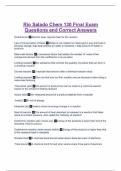
-
Rio Salado Chem 130 Final Exam Questions and Correct Answers
- Exam (elaborations) • 12 pages • 2024
-
- $9.99
- + learn more
Endothermic Absorbs heat, requires hear for the reaction Law of Conservation of Mass Matter is not created nor destroyed in any chemical or physical change, ergo total amount of matter in reactants = total amount of matter in products Mole-mole factors a conversion factor that relates the number of moles of two compounds derived from the coefficients in an equation Limiting reactant the substance that controls the quantity of product that can form in a chemical reaction Excess reactant a rea...
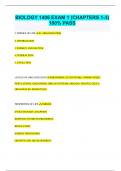
-
BIOLOGY 1406 EXAM 1 (CHAPTERS 1-3) 100% PASS
- Exam (elaborations) • 11 pages • 2024
- Available in package deal
-
- $9.49
- + learn more
BIOLOGY 1406 EXAM 1 (CHAPTERS 1-3) 100% PASS 5 THEMES OF LIFE 1. ORGANIZATION 2. INFORMATION 3. ENERGY AND MATTER 4. INTERACTION 5. EVOLUTION LEVELS OF ORGANIZATION BIOSPHERE, ECOSYSTEMS, COMMUNITIES, POPULATIONS, ORGANISMS, ORGAN SYSTEMS, ORGANS, TISSUES, CELLS, ORGANELLES, MOLECULES. PROPERTIES OF LIFE ORDER EVOLUTIONARY ADAPTION RESPOND TO THE ENVIRONMENT REGULATION ENERGY PROCESSING GROWTH AND DEVELOPEMENT REPRODUCTION WHAT IS BIOLOGY THE STUDY OF LIFE. ...
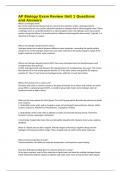
-
AP Biology Exam Review Unit 1 Questions and Answers
- Exam (elaborations) • 8 pages • 2024
-
- $10.39
- + learn more
AP Biology Exam Review Unit 1 Questions and Answers What is a hydrogen bond? One of the weak chemical bonds that are central to the chemistry of life; a hydrogen bond is characterized by the non-covalent attraction between a hydrogen and an electronegative atom. When a hydrogen atom is covalently bonded to an electronegative atom, the hydrogen atom has a partial positive charge that allows it to be attracted to a different electronegative atom nearby. Typically, it is attracted to nitrogen or ...
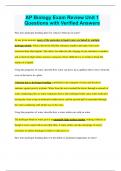
-
AP Biology Exam Review Unit 1 Questions with Verified Answers
- Exam (elaborations) • 15 pages • 2024
- Available in package deal
-
- $9.99
- + learn more
AP Biology Exam Review Unit 1 Questions with Verified Answers How does hydrogen bonding allow for cohesive behavior in water? At any given moment, many of the molecules in liquid water are linked by multiple hydrogen bonds, which collectively hold the substance together and make water more structured than other liquids. This allows for adhesion (the clinging of one substance to another) and a relatively high surface tension (a measure of how difficult it is to stretch or break the surfa...
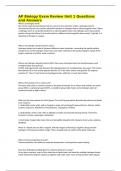
-
AP Biology Exam Review Unit 1 Questions and Answers
- Exam (elaborations) • 8 pages • 2024
- Available in package deal
-
- $10.39
- + learn more
AP Biology Exam Review Unit 1 Questions and Answers What is a hydrogen bond? One of the weak chemical bonds that are central to the chemistry of life; a hydrogen bond is characterized by the non-covalent attraction between a hydrogen and an electronegative atom. When a hydrogen atom is covalently bonded to an electronegative atom, the hydrogen atom has a partial positive charge that allows it to be attracted to a different electronegative atom nearby. Typically, it is attracted to nitrogen or ...
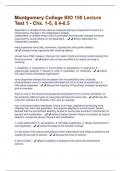
-
Montgomery College BIO 150 Lecture Test 1 - Chs. 1-5, 8.4-8.5 Questions And Answers Already Graded A+
- Exam (elaborations) • 10 pages • 2024
-
- $7.99
- + learn more
dependent: a variable whose value is measured during an experiment to see if it is influenced by changes in the independent variable. independent: a variable whose value is controlled and manually changed during an experiment to reveal effects on the dependent. - ️️define: dependent vs. independent variables living organisms have cells, movement, reproduction and growth abilities. - ️️compare living organisms with nonliving objects. viruses have DNA. however, they are not made of ...

-
AP Biology Exam Review Unit 1 Questions and Answers
- Exam (elaborations) • 8 pages • 2024
-
- $10.39
- + learn more
AP Biology Exam Review Unit 1 Questions and Answers What is a hydrogen bond? One of the weak chemical bonds that are central to the chemistry of life; a hydrogen bond is characterized by the non-covalent attraction between a hydrogen and an electronegative atom. When a hydrogen atom is covalently bonded to an electronegative atom, the hydrogen atom has a partial positive charge that allows it to be attracted to a different electronegative atom nearby. Typically, it is attracted to nitrogen or ...
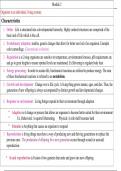
-
BIOD 101 Module 2 Studyguide : Organism is an individual, living creature
- Other • 13 pages • 2023
-
- $18.49
- + learn more
Organism is an individual, living creature. Characteristics 1. Order : Life is structured into a developmental hierarchy. Highly ordered structures are comprised of the basic unit of life which is the cell. 2. Evolutionary adaption: smaller, genetic changes that allow for better survival of an organism. Example color camouflage. (Generational evolution) 3. Regulation is a Living organisms are sensitive to temperature, environmental stresses, pH requirements etc. and go to great lengths t...
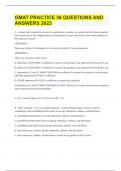
-
GMAT PRACTICE |36 QUESTIONS AND ANSWERS 2023
- Exam (elaborations) • 16 pages • 2023
- Available in package deal
-
- $14.49
- + learn more
impetus (n.) the force or energy with which something moves; momentum. obsolete (adj.) no longer in use or in practice. probable (adj.) likely to happen. susceptibility (n.) a vulnerability or lack of resistance to damage or disease ; easily affected persecuted v. annoyed or harassed consistently intestine (n.) That part of the digestive tube below or behind the stomach, extending to the anus. smearing (Adj.) rubbing all over bowers (n.) ...

$6.50 for your textbook summary multiplied by 100 fellow students... Do the math: that's a lot of money! Don't be a thief of your own wallet and start uploading yours now. Discover all about earning on Stuvia


